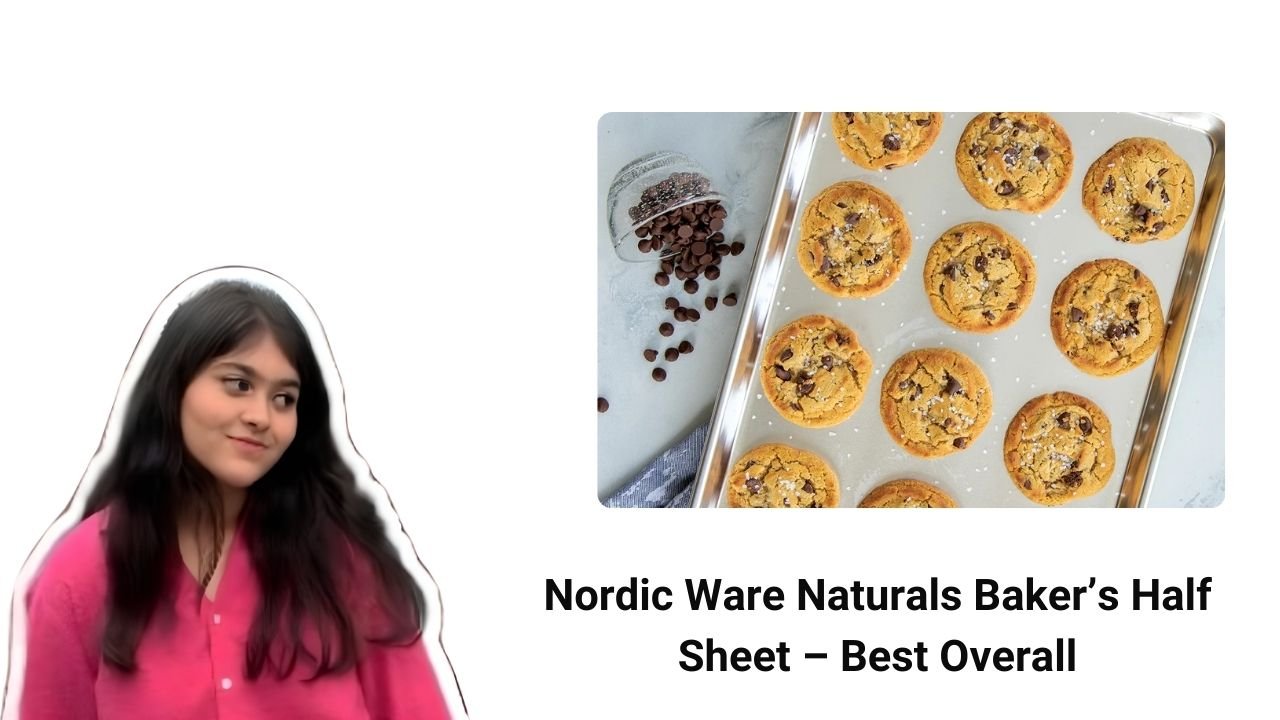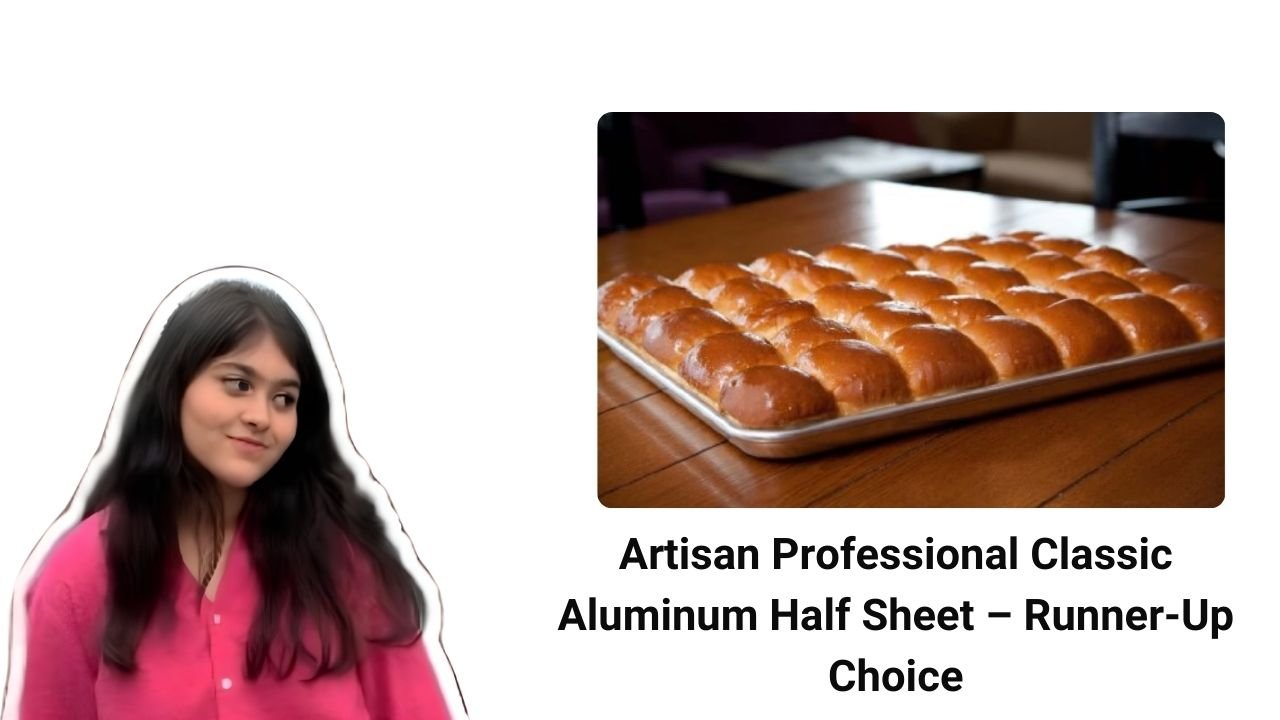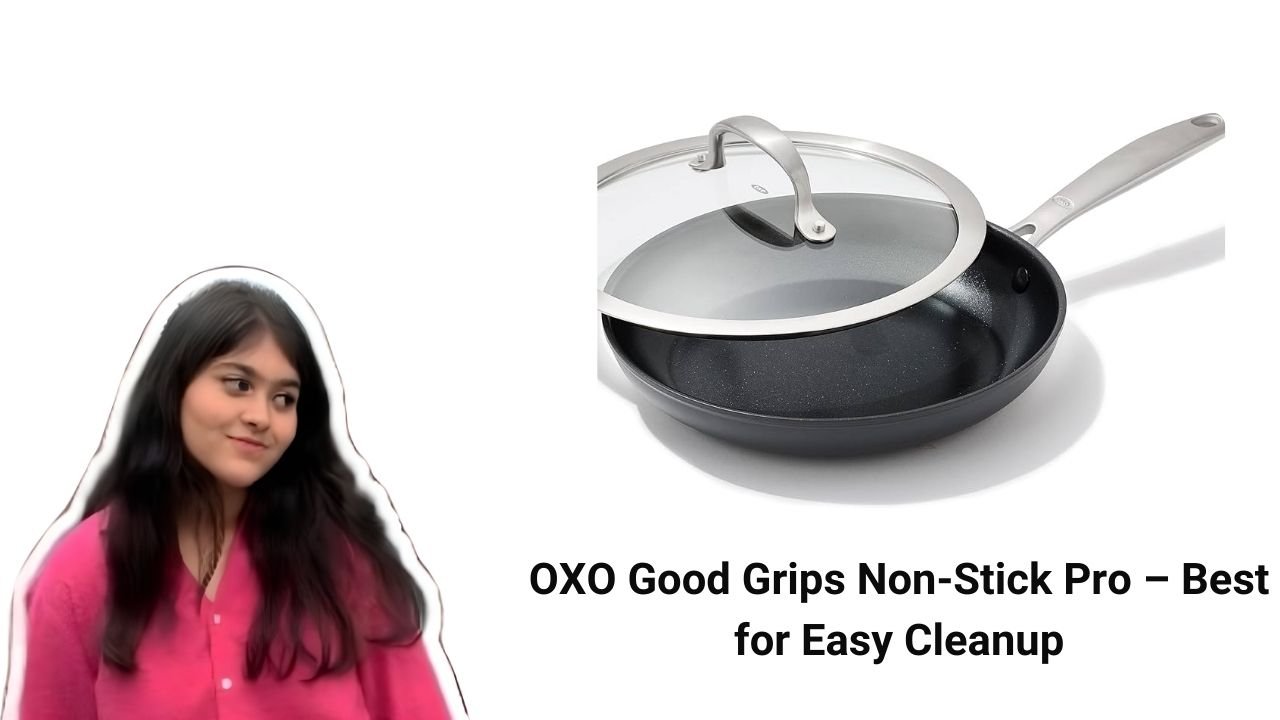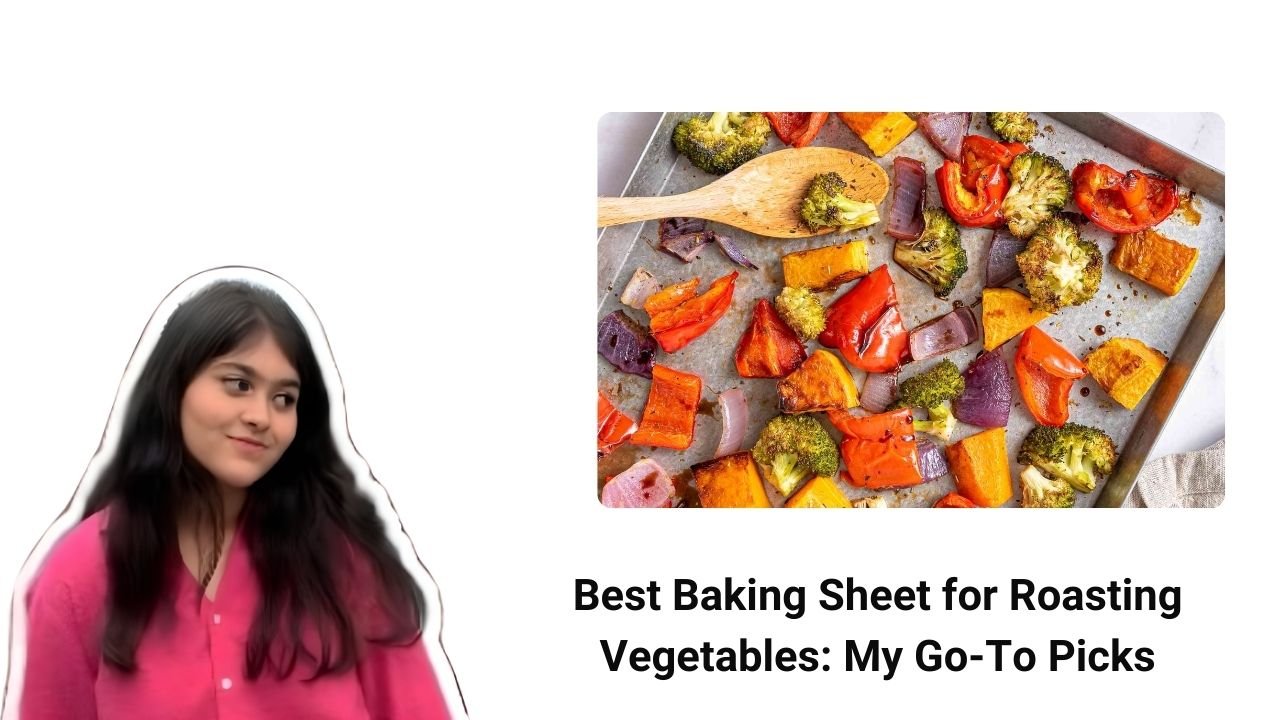Introduction: Why the Right Baking Sheet Changes Everything
Let’s be real: nothing is more disappointing than soggy roasted vegetables. You plan a wholesome dinner, preheat the oven, toss your veggies in olive oil and seasoning, and wait. But instead of crispy edges and caramelized bits, you get limp, unevenly cooked food. It’s not your seasoning. It’s not your oven. More often than not, it’s your baking sheet.
Over the years, I’ve roasted everything from cauliflower and carrots to chickpeas and butternut squash. After dozens of pans and hundreds of meals, I’ve found what truly works. In this article, I’m sharing my go-to picks for the best baking sheet for roasting vegetables—not just because they’re popular, but because I’ve tested them myself, week after week, year after year.
Whether you’re meal-prepping for the week or just tossing together a last-minute tray of roasted potatoes, the right sheet pan can transform your food. So let’s dive into the world of baking sheets for ovens, compare materials, and see which ones are actually worth your money.
What Makes a Great Roasting Pan?
Before I introduce you to my top picks, let’s talk about what really matters in a roasting pan:
- Material: Aluminum conducts heat well. Stainless steel is durable. Nonstick offers easy cleanup.
- Structure: Warping at high heat is a big no. Reinforced rims help prevent that.
- Size: A standard half sheet (around 18×13 inches) is perfect for most home ovens.
- Surface: Smooth, non-toxic, and easy to clean is the sweet spot.
- Performance: Even browning, quick caramelization, and zero sogginess.
Once you’ve used a well-made pan, you’ll understand why it makes such a difference. The pans I recommend below are tested and trusted—and each has its own strengths depending on your needs.
1. Nordic Ware Naturals Baker’s Half Sheet – Best Overall

Let me start by saying this: I’ve owned the Nordic Ware baking sheet for over five years. It’s been through everything—roasting, baking, broiling—and it still looks good. Not perfect, but beautifully broken in, like a favorite skillet or your coziest hoodie.
What sets it apart is the pure aluminum construction, which conducts heat evenly and quickly. Your sweet potatoes won’t burn on one side and undercook on the other. Instead, they brown like they’re supposed to—with crispy edges and a soft, fluffy center.
Another huge win? The steel-reinforced rim. It’s designed to prevent warping, even at temperatures north of 450°F. That matters when you’re roasting dense foods like squash or beets. You want your pan to stay flat so the oil spreads evenly, not pool in corners.
I also love the versatility. Want to bake cookies? Line it with parchment. Roasting brussels sprouts? Go without. It works both ways.
Here’s a quick snapshot:
| Feature | Details |
| Material | Pure aluminum |
| Size | 17.9 x 12.9 x 1 inches |
| Weight | 1.7 pounds |
| Rim | Encapsulated steel |
| Price | ~$11 per pan (2-pack deal!) |
| Dishwasher Safe? | Hand wash recommended |
Pros:
- Distributes heat evenly
- Resists rust over time
- Doesn’t warp easily
- Budget-friendly
Cons:
- Can discolor with acidic foods
- Scratches easily with metal utensils
If you’re wondering what the best sheet pan for roasting vegetables is, this is it. No fluff, no gimmicks—just good, old-fashioned performance.
2. Artisan Professional Classic Aluminum Half Sheet – Runner-Up Choice

The Artisan Professional baking sheet is another favorite, and honestly, if Nordic Ware didn’t exist, this would probably be my top pick. It shares many of the same qualities—uncoated aluminum, a strong rim, and consistent results.
Where it shines most is in roasting. I’ve roasted asparagus, cherry tomatoes, and even marinated tofu on this pan. Everything cooks evenly and browns beautifully. The surface is smooth enough that veggies don’t stick, even without parchment. That’s a huge win for anyone trying to cut back on waste or save on liners.
Why isn’t it number one? The price. It’s slightly higher than Nordic Ware but doesn’t necessarily outperform it. Still, it’s a sturdy, heavy-duty option that will outlast most nonstick alternatives.
Specs at a glance:
| Feature | Details |
| Material | Uncoated aluminum |
| Size | 18 x 13 inches |
| Weight | 1.2 pounds |
| Rim | Reinforced edge |
| Price | ~$23.99 |
| Dishwasher Safe? | Hand wash recommended |
Pros:
- Excellent heat conductivity
- Smooth surface = less sticking
- Resists rust
Cons:
- Pricier than some competitors
- Finish can dull in dishwasher
In short, this is a solid second-best that performs nearly as well as my top pick. If you can snag it on sale, it’s definitely worth it. For those seeking a heavy-duty stainless steel baking sheet vibe (without the actual steel), this one checks most boxes.
3. OXO Good Grips Non-Stick Pro – Best for Easy Cleanup

Let’s talk about nonstick. I know some bakers side-eye it, but when you’re roasting sticky things like glazed carrots or maple Brussels sprouts, nonstick can be a lifesaver.
The OXO Nonstick Half Sheet Pan is my favorite in this category. It’s made with ceramic-reinforced aluminized steel, so it combines heat efficiency with durability. The surface is textured, not smooth, and that’s actually a plus. Those tiny ridges let air circulate underneath your food, promoting faster browning.
When I roasted cauliflower florets tossed in curry and oil, they came out golden and crisp—no parchment, no sticking. That’s rare for a nonstick pan.
One thing to note: this pan is heavier than most. It’s not ideal if you’re flipping veggies mid-roast one-handed. And the grooved surface, while useful for airflow, takes more effort to clean if oil pools in the ridges.
Let’s look at the details:
| Feature | Details |
| Material | Aluminized steel w/ nonstick |
| Size | 17.84 x 2.97 x 1.25 inches |
| Weight | 2.3 pounds |
| Rim | Rolled edges |
| Price | ~$34.95 |
| Dishwasher Safe? | Yes |
Pros:
- Truly nonstick surface
- Promotes even browning
- Dishwasher safe
- Doesn’t warp
Cons:
- Grooves can trap residue
- Nonstick may wear over time
- Heavier than aluminum sheets
For those who roast often and hate cleanup, this is the best nonstick baking sheet for both cookies and vegetables. If you’re looking for the best sheet pan for roasting vegetables and don’t want to deal with liners or sprays, this one’s for you.
Choosing the Right Material: What Really Matters for Roasting
When it comes to finding the best baking sheets, the material isn’t just a technicality—it’s everything. It determines how your vegetables cook, how easily they release, and even how long your pan will last. Let’s break down the three most common types and how they compare.
Aluminum: The Gold Standard
Most professional kitchens—and many home cooks—swear by uncoated aluminum. Why? Because it conducts heat evenly and quickly. That means less time waiting for your oven to warm your veggies and more even caramelization across the surface. Both the Nordic Ware and Artisan Professional pans use uncoated aluminum for a reason.
However, aluminum is reactive. If you’re roasting tomatoes, vinegar-glazed veggies, or lemony potatoes, the acid can leave marks or a metallic taste. Lining the pan with parchment paper solves this easily.
Aluminized Steel: Built for Tough Use
Used in the OXO Good Grips Non-Stick Pro, aluminized steel is coated to resist corrosion and increase durability. It’s heavier than aluminum but holds heat well and resists warping. The ceramic-reinforced coating helps make cleanup a breeze and reduces the need for foil or paper.
Stainless Steel: Heavy-Duty, But Heat-Challenged
You may have heard of heavy duty stainless steel baking sheets. While they last forever and look beautiful, stainless steel doesn’t conduct heat as well as aluminum. That means potential hot spots and slower cooking times. It’s great for durability, not so much for perfect roasted broccoli.
Best baking pan material? If roasting is your goal, uncoated aluminum still wins—hands down.
Size Matters: Which One Fits Your Oven and Needs?
The most common and versatile size is the half sheet pan, which typically measures around 18 x 13 inches. It’s big enough to roast a tray of mixed veggies but small enough to fit in standard home ovens. If you want to roast for a crowd or meal prep, a full-size commercial pan might sound tempting—but it likely won’t fit your oven rack.
Here’s a quick breakdown of popular sheet pan sizes:
| Size Name | Dimensions (inches) | Best For |
| Full Sheet | 26 x 18 | Commercial kitchens |
| Half Sheet | 18 x 13 | Roasting vegetables, general baking |
| Quarter Sheet | 13 x 9 | Small batches, side dishes |
| Eighth Sheet | 9 x 6.5 | Toasting nuts, reheating leftovers |
| Jelly Roll Pan | 15 x 10 | Baking bars, roasting a small portion |
I always recommend starting with a half sheet if you’re new. Once you fall in love with roasting (and you will), you can branch out to Nordic Ware’s quarter and eighth pans, which are perfect for small-batch meals or oven-to-table serving.
The Best Non-Toxic Baking Sheets for Peace of Mind
Health-conscious cooks are becoming more mindful of the materials they use. If you’re someone who avoids chemicals in cookware, you’re probably searching for the best baking sheets non toxic.
Here’s what to look for:
- Uncoated aluminum: Naturally non-toxic, just avoid direct contact with acidic ingredients.
- Ceramic-reinforced nonstick: Safer than traditional Teflon-style coatings.
- Avoid PTFE and PFOA: These are synthetic chemicals found in some nonstick products.
The Nordic Ware Naturals pan is a great choice here. It’s uncoated, free of chemical finishes, and has earned trust from countless health-conscious home cooks. Pair it with parchment paper or a silicone mat if you’re extra cautious.
Real-World Use: Tips and Tricks for Perfect Roasted Vegetables
Even the best baking sheet for roasting vegetables won’t save you from soggy outcomes if your technique’s off. Over the years, I’ve picked up a few tricks that make a huge difference:
Don’t overcrowd the pan
Give your veggies room to breathe! When they’re piled up, they steam instead of roast. Use two pans if needed.
Preheat the pan
Toss your empty pan in the oven while it preheats. This creates an instant sear on contact—great for root veggies.
Dry your vegetables
Wet veggies = steam = mush. After washing, pat them dry with a kitchen towel.
Flip halfway through
Toss your vegetables halfway through roasting to get golden edges on all sides.
Use high heat
Don’t be afraid of 425°F or even 450°F. Just make sure your sheet pan is warp-resistant (like Nordic Ware or Artisan).
Caring for Your Baking Sheets: Make Them Last
A good baking sheet should last for years—if you treat it right. Here’s how to get the most out of your investment:
- Hand wash only: Especially with uncoated aluminum. Dishwashers can discolor or damage the surface.
- Skip metal utensils: They’ll scratch your nonstick or even your aluminum.
- Use parchment or silicone mats: These prevent sticking, reduce cleanup, and preserve your pan’s surface.
- Avoid cooking acidic foods directly on aluminum: Use a liner for tomatoes, vinegar-based glazes, or citrus-heavy marinades.
- Don’t soak for hours: If something sticks, soak briefly and use a soft scrubber—no steel wool!
Final Thoughts: The Best Baking Sheet for Roasting Vegetables Is One You’ll Use Often
At the end of the day, the best baking sheet for roasting vegetables isn’t just the one with the highest price tag or trendiest brand. It’s the one that makes you excited to roast dinner, that fits your oven perfectly, and that turns humble broccoli into something crave-worthy.

Hey, I’m Nandoza Ahammad, passionate food enthusiast and creator of narzcookingcave.com, shares delicious recipes and cooking tips worldwide.

